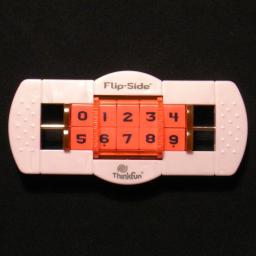


Flip-Side is a recent puzzle by Thinkfun. It consists of a frame containing 10 numbered blocks in two rows of five. In the centre of the frame is a turntable that holds 3 blocks from each row. When turned, the three blocks in the top row swap with the three blocks directly beneath them. Each row can slide left or right, so you can choose which three adjacent blocks in a row are flipped to the other row. The blocks are numbered, and the aim is of course to arrange them in numerical order after they have been mixed, i.e. 01234 on the top row, 56789 on the bottom row.
Several possible patterns are suggested on the Flip-Side packaging. These are shown below:
| One In Front | Right To Left | Evens And Odds | Upside Down | Cycle | Reverse Cycle |
|---|---|---|---|---|---|
| 12345 67890 |
43210 98765 |
02468 13579 |
56789 01234 |
01234 98765 |
98765 01234 |
Flip-Side was invented by Ferdinand Lammertink, who also invented Topspin, Backspin, and Triple Cross. The puzzle's patent, US 2006/279041, was published 14 December 2006.
If your browser supports it, you can click on the link below to play with a Javascript version of Flip-Side.
There are 10 pieces, so there are at most 10! = 3,628,800 positions with both sliders centralised. All these positions can be achieved. There are 9 ways the sliders can be arranged, so if you insist on distinguishing those then there are 9 times as many possible positions.
I have calculated through all positions on my computer, and the results are in the table below. It shows that any position can be solved in at most 11 flips (8.0429 on average).
| Depth | # positions |
|---|---|
| 0 | 1 |
| 1 | 9 |
| 2 | 67 |
| 3 | 493 |
| 4 | 3,469 |
| 5 | 23,385 |
| 6 | 145,212 |
| 7 | 714,611 |
| 8 | 1,579,683 |
| 9 | 1,075,898 |
| 10 | 85,968 |
| 11 | 4 |
| total | 3,628,800 |
The four hardest positions, the ones that need 11 flips, are as follows:
| 58069 34127 |
89672 03514 |
27856 03914 |
58469 72301 |
Phase 1: Solve top left number, number 0.
Phase 2: Solve bottom left number, number 5
This is done in the same way as phase 1, except that in step b you must never put the previously solved piece 0 in the flip area. The steps are therefore:
Phase 3: Solve next two numbers, 1 and 6.
These are solved in exactly the same way, just make sure you never put any previously solved piece in the flip area.
The next section will be solved using a simple move sequence which cycles 3 pieces. Suppose you have both sliders in the central positions. Now do the following steps:
1. Move top slider left.
2. Flip.
3. Move top slider right.
4. Flip.
5. Move bottom slider left.
6. Flip.
7. Move bottom slider right.
8. Flip.

This cycles around anti-clockwise the right-most two pieces of the bottom row and the right-most piece of the top row. I'll call this The Cycle. Using a fairly self-explanatory notation, this can be written as:
The Cycle: Ul / Ur / Dl / Dr /
Note that you need not start the sequence with the sliders in the central position. One or both of the sliders may be shifted to the right beforehand, and it will still work, though the Cycle then obviously moves different pieces.
Phase 4: Solve the top row middle piece, number 2.
Phase 5: Solve the bottom row middle piece, number 7.
Phase 6: Solve piece 3.
Phase 7: Solve piece 8.
Phase 8: Solve pieces 4 and 9.
Note: I can never remember a move sequence like the one in the last phase. Its use can be avoided however, by examining the permutation parity. Every flip changes the permutation parity. The parity is not changed by the phases 5-8 (they all use an even number of flips) but we can set the correct parity in phase 4.
Below is an alternative to phase 4, which puts piece 2 correct and ensures the permutation has the correct parity, thus avoiding phase 8. If you have arrived at phase 8 and find you need to make a single swap, then you can fix this by doing the moves in step b of the alternative phase 4 below, and then doing phases 5-7 again.
Alternative Phase 4: Solve the top row middle piece, number 2, and fix parity.
Nice patterns:
These all start with the rows centralised.